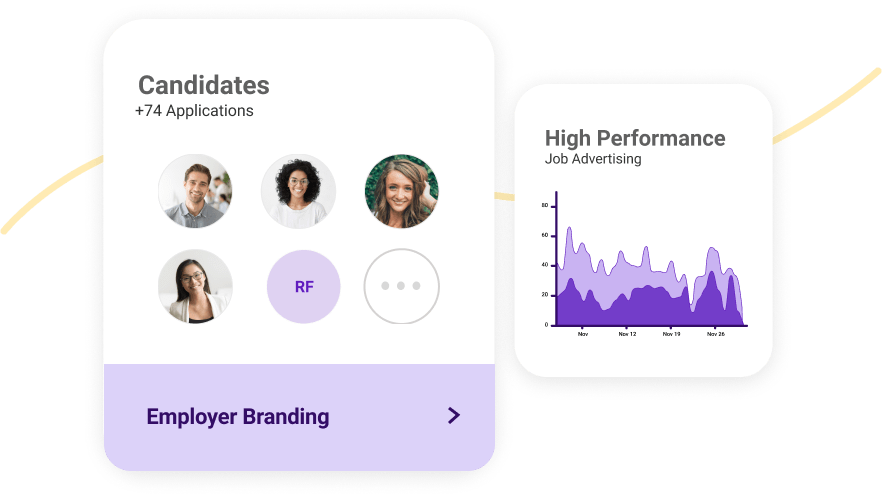Learn to Optimize High-Volume Recruitment Planning
All successful recruiting strategies have one thing in common: They started with a plan.
Learning how to develop a solid recruitment plan is a crucial part of a recruiter’s job. And the higher the volume of hires you need, the more prepared you should be.
What should a high-volume recruitment plan include? Here are a few elements:
- Hiring goals
- Previous strategy analysis
- Recruiting schedule
- High-volume budget
- Backup plan
Let’s walk through the steps in the recruitment planning process that will set you up for success.
Groundwork Before You Start Planning
Before you put the solid stuff – the schedule and budget – together, it’s important to do some groundwork. What are your hiring goals? How did you perform last year? Is your team fully equipped to take on this challenge?
Having a good understanding of your recruiting needs is important, so do this groundwork before you put pen to paper.
Determine your hiring goals

A high-volume recruitment plan should be based on your business goals.
In general, recruitment goals revolve around the same kind of thing:
- Attracting a higher volume of candidates
- Attracting a higher standard of candidates
- Making hires in a timely manner
Use the S.M.A.R.T. goal methodology to increase the likelihood of meeting them! Are your objectives Specific, Measurable, Attainable, Relevant, and Time-based? Try something like these:
- Make ___ hires by June
- Increase this year’s retention rate by ___%
- Receive ___% more qualified candidates in Q3
Creating clear goals like these makes it easier to see when you’ve met an objective because of your recruiting efforts.
Analyze your previous hiring strategy
Before you do anything a second time, you should assess how it went the first time.
Utilize your hiring metrics to assess how successful you were in past recruiting cycles. What were your hiring goals last time around? Did you meet them?
Consider if you communicated the positions well and if you reached your desired number of applicants. Think about how the hires themselves worked out. Did your retention rate suffer?
Also look at your sourcing channel effectiveness and turnover per source to see which sources performed the best. Examine your budget and see which recruiting costs were the biggest burden to you. Were your recruiting expenses worth the cost?
Finally, analyze how well you and your team handled the responsibilities. Team communication is an increasingly present struggle for recruiting teams everywhere. Consider implementing project management software to help your team’s productivity.
Identifying the strengths of your previous recruiting plans will help you know which elements of your strategy are working. Additionally, figuring out where you could use some help is not a failing, but an opportunity to improve.
Conduct a skills gap analysis
A skills gap analysis is a way of looking at the strengths and weaknesses of your organization and figuring out what you’re missing. This informs you which skills and which kinds of workers you need to add to the team.
Here are some questions to ask yourself within your skills gap analysis:
- What skills is your team lacking?
- Which of your teams aren’t operating at maximum productivity and could use more help?
- Which jobs have the potential to become automated in the near future?
- How is the talent shortage affecting your industry?
- What skills needs are currently on the rise?
- Which positions will your company need in the future?
This will help you reassess your projected hiring needs and prepare to put plans on paper.
Starting a High-Volume Recruitment Plan

Now that you’ve done the groundwork, it’s time to start your strategic volume hiring planning.
The recruiting process takes a lot of time and effort to produce the results that you’re looking for. Take the work you put into your analysis and form a strategy that allows you to meet your hiring goals.
Estimate the number of hires you need to make
First, you’ll need to identify the positions that you are hiring for and the number you need of each. Consider the number of locations you’re operating in and the number of new hires you typically have in a year.
Don’t forget to factor in your turnover rate as well to account for the positions of people you’re assuming will leave within the year.
Finally, think about any other factors that could contribute to you needing a greater or lower number of hires. Industry trends, changes in your market, new competitors, and technology advancements are just some of the things to consider here.
Your budget and your timeline – the two most important pieces to a high-volume recruitment plan – are directly affected by these estimates. Take care when making them.
Create a recruiting schedule
Next, it is imperative to have a recruiting schedule as part of your high-volume plan. For one thing, deadlines motivate people to get their job done. For another, teams in any industry can’t function for that long without a full staff.
Create a recruiting calendar with the ideal number of hires per quarter, month, and even week. Pencil in any major sourcing events that you’ll be hosting. This means getting hiring events on the schedule months in advance, but also making note of any marketing campaigns to run and when your busy season will be. Seasonality is a major factor in some industries, so make sure to note it in your plans if it applies to you.
High-volume scheduling becomes even more important and automatable in the interviewing process. However, getting key things on the calendar and identifying your timely needs is a critical part of a hiring plan.
Put together your high-volume recruiting budget
Your budget sets the tone for your entire year of hiring. To get it, you’ll need to calculate your cost per hire and multiply it by your annual projected headcount, estimated in the previous step.
Start by classifying expenses into fixed and variable costs. Common fixed recruiting costs include technology costs, team salaries, and agency costs. Some variable costs include job advertising costs, employer branding campaigns, referral incentives, and hiring events.
When you factor in all your expenses, sum them up to get your yearly recruiting expense. You can also divide this by your estimated number of hires to get your cost per hire, an important metric to watch in high-volume hiring.
Ideally, you’ll want to keep your cost per hire low. But remember that nothing can get done without spending a little cash, and certain channels are more productive the more you invest into them.
Begin the process!

Even though the planning starts before the recruiting process begins, a good understanding is still essential to a successful cycle.
The brightest TA pros will plan for any roadblocks that are likely to emerge at each stage. Here are some major steps and plans you can make to stay ahead of the curve:
- Job announcement. Write a compelling job description that clearly communicates what kind of worker you are looking for. If you’re getting too many unqualified applicants, consider bulking up your experience requirements. If you’re getting too few candidates, try the opposite! Use job optimization tips to make sure your postings stand out above your competitors.
- Sourcing and advertising. Time to start promoting! Use a multi-channel sourcing strategy to get the job seekers you need. If you’re not getting the amount of quality candidates that you’re looking for, your sourcing may be the cause. Get creative by sourcing via social media, niche job boards, and employee referrals. Improve your advertising by getting a better idea of your target candidate personas and using better targeting methods.
- Interviewing. Make sure your interviewers are trained and prepared. Have a list of questions to fill the allotted time and scan your candidates for the skills you’re looking for. Additionally, make sure you’re asking interviewees the same questions as to give everyone an equal shot.
- Background checks, assessments, etc. Consider adding background checks and skills or personality assessments to your recruiting strategy. These can be helpful for narrowing down your applicant pool, finding good cultural fits for your company, and reducing potential hiring biases.
- Making an offer. There is always the off chance that someone won’t accept an offer your company extends. Go beyond the ABC (“Always Be Closing”) method and offer good benefits that cater to your target audience. High salaries are one thing, but a good culture and strong employer brand go a long way. Providing a great candidate experience throughout the entire hiring process is the best way to ensure that people accept your offer.
Optimizing Your Recruitment Plans

Recruiting at scale requires a well-thought-out plan beforehand, but also lots of optimization throughout.
In general, you should try to keep numbers like the budget as unchanging as possible. However, your sourcing, candidate nurturing, and recruitment marketing strategies should be flexible and able to change as it makes sense.
Additionally, use technology to save you time and improve your recruiting process. Applicant tracking systems (ATS) are increasingly competent at aiding recruiters in repeatable tasks like resume scanning and interview scheduling. Find one that works for you and consider adding other technologies (sourcing tools, programmatic advertising software, etc.) to your toolbox.
A final thing to keep in mind is to use metrics wherever you can throughout the hiring process. Keeping your cost per hire low and your quality of candidates high are some good goals to keep in mind. But you won’t know what factors lead to achieving those goals unless you analyze relevant metrics.
Following these methodical steps to recruitment planning to reach even your loftiest hiring goals.
See more of our high-volume recruiting guide →



